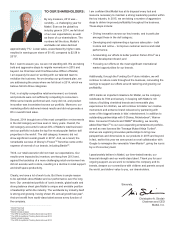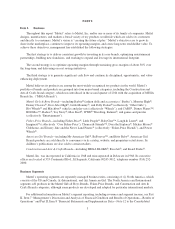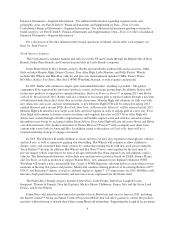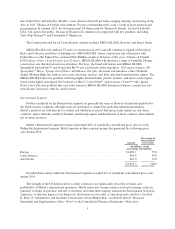Mattel 2014 Annual Report Download - page 13
Download and view the complete annual report
Please find page 13 of the 2014 Mattel annual report below. You can navigate through the pages in the report by either clicking on the pages listed below, or by using the keyword search tool below to find specific information within the annual report.Competition among the above companies is intensifying due to recent trends towards shorter life cycles for
individual toy products and an increasing use of high technology in toys. In addition, as a result of the
phenomenon of “children getting older younger” resulting from children outgrowing toys at younger ages, Mattel
competes with companies that sell products outside the toy aisle, such as electronic consumer products and video
games. Competition continues to be heavily influenced by the fact that a small number of retailers account for a
large portion of all toy sales, allocate the shelf space from which toys are viewed, and have direct contact with
parents and children through in-store purchases, coupons, and print advertisements. Such retailers can and do
promote their own private-label toys, facilitate the sale of competitors’ toys, and allocate shelf space to one type
of toy over another. Competition is also intensifying due to the availability of online-only distributors, including
Amazon.com, which are able to promote a wide variety of toys and represent a wide variety of toy
manufacturers, and, with limited overhead, do so at a lower cost.
Seasonality
Mattel’s business is highly seasonal, with consumers making a large percentage of all toy purchases during
the traditional holiday season. A significant portion of Mattel’s customers’ purchasing occurs in the third and
fourth quarters of Mattel’s fiscal year in anticipation of holiday buying. These seasonal purchasing patterns and
requisite production lead times create risk to Mattel’s business associated with the underproduction of popular
toys and the overproduction of less popular toys that do not match consumer demand. Retailers have also been
attempting to manage their inventories more tightly in recent years, requiring Mattel to ship products closer to the
time the retailers expect to sell the products to consumers. These factors increase the risk that Mattel may not be
able to meet demand for certain products at peak demand times or that Mattel’s own inventory levels may be
adversely impacted by the need to pre-build products before orders are placed. Additionally, as retailers manage
their inventories, Mattel experiences cyclical ordering patterns for products and product lines that may cause its
sales to vary significantly from period to period.
In anticipation of retail sales in the traditional holiday season, Mattel significantly increases its production
in advance of the peak selling period, resulting in a corresponding build-up of inventory levels in the first three
quarters of its fiscal year. Seasonal shipping patterns result in significant peaks in the third and fourth quarters in
the respective levels of inventories and accounts receivable, which result in seasonal working capital financing
requirements. See Part II, Item 8 “Financial Statements and Supplementary Data—Note 5 to the Consolidated
Financial Statements—Seasonal Financing and Debt.”
Product Design and Development
Through its product design and development group, Mattel regularly refreshes, redesigns, and extends
existing toy product lines and develops innovative new toy product lines for all segments. Mattel believes its
success is dependent on its ability to continue these activities effectively. See Item 1A “Risk Factors.” Product
design and development activities are principally conducted by a group of professional designers and engineers
employed by Mattel. During 2014, 2013, and 2012, Mattel incurred expenses of $209.5 million, $201.9 million,
and $195.1 million, respectively, in connection with the design and development of products, exclusive of royalty
payments. See Part II, Item 8 “Financial Statements and Supplementary Data—Note 13 to the Consolidated
Financial Statements—Supplemental Financial Information.”
Additionally, independent toy designers and developers bring concepts and products to Mattel and are
generally paid a royalty on the net selling price of products licensed to Mattel. These independent toy designers
may also create different products for other toy companies.
Advertising and Marketing
Mattel supports its product lines with extensive advertising and consumer promotions. Advertising takes
place at varying levels throughout the year and peaks during the traditional holiday season. Advertising includes
7
























